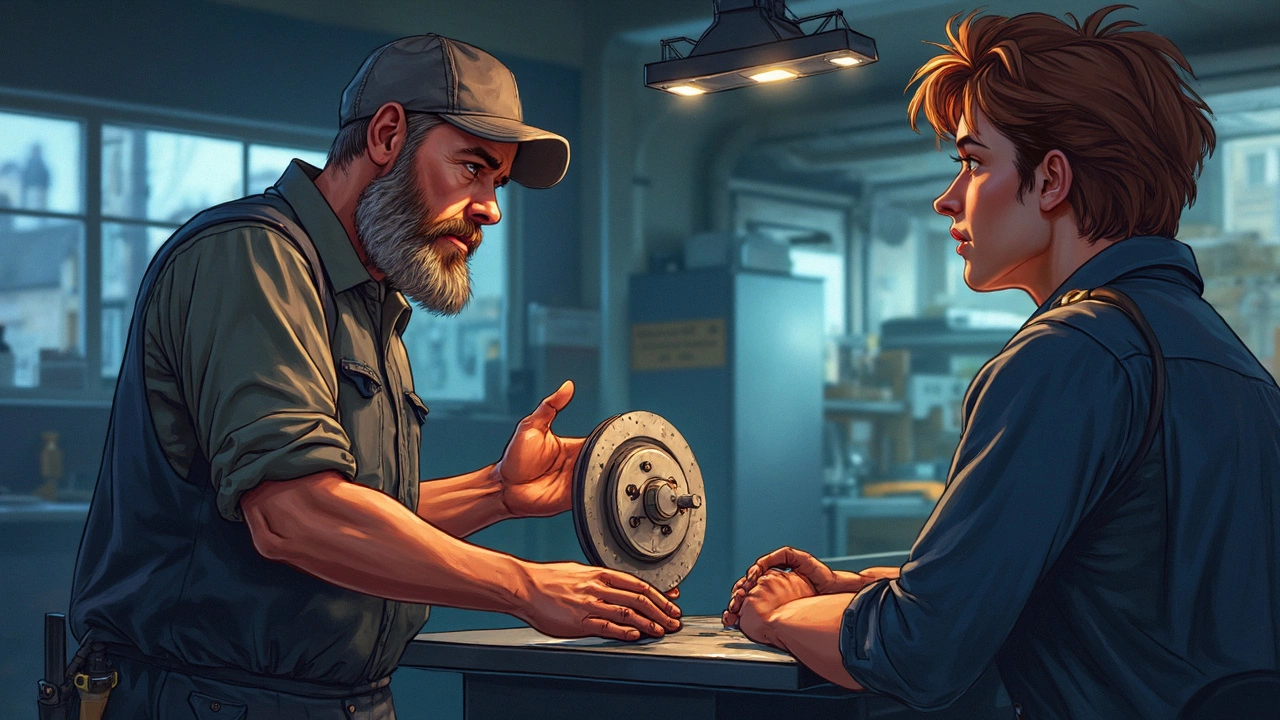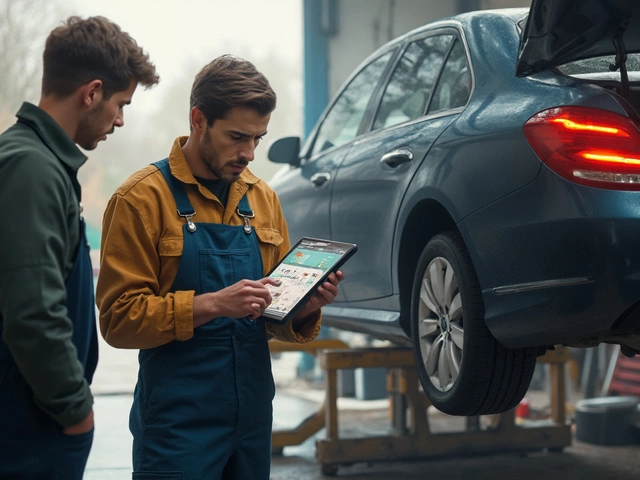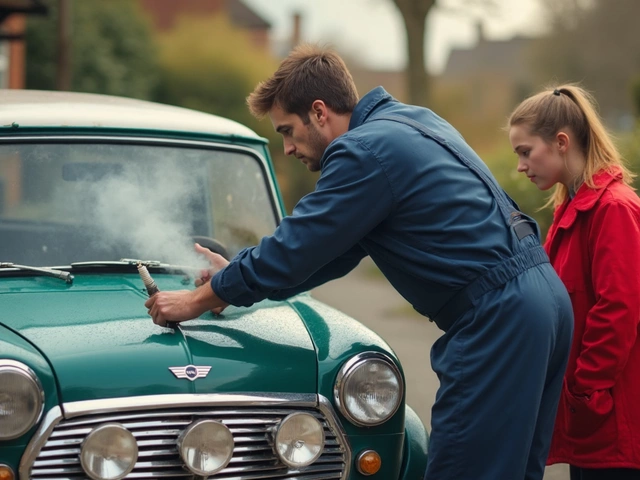Your brakes help you stop—pretty basic, right? But even a tiny problem with your rotors can mess that up in a big way. People usually wait until their car makes horrible sounds or feels shaky, but by then, getting stuck with a tow truck is just one red light away.
If you’re hearing scraping or grinding or your steering wheel wiggles every time you slow down, it could be your rotors waving a red flag. Most folks blame the brake pads. But here’s the truth: pads often wear out fast when rotors are ignored, so it becomes a double whammy on your wallet.
Rotors usually don’t fail out of the blue. If you pay attention to what your brakes are saying—literally, listen and feel—you can spot trouble before it turns into a roadside breakdown. Simple checks with a flashlight or running your fingers on the edge of the rotor can save you hundreds. We’ll break down all the warning signs and even some easy tests you can do at home (without fancy tools or a mechanic’s bill).
If you’re not sure what’s normal or what’s cause for panic, you’re in the right place. Understanding bad rotors is one of those car basics anyone can learn in a few minutes—and it’s way easier than changing a tire in the rain.
- Why Rotors Matter for Braking
- Big Signs Your Rotors Are Failing
- Strange Noises and What They Mean
- Feeling Vibrations: What to Watch Out For
- Checking Rotors at Home
- When to Replace (and When It’s Not the Rotors)
Why Rotors Matter for Braking
Rotors are those big flat discs you can see behind your wheel rims. When you hit the brake pedal, your car's brake pads squeeze against the rotors. This simple bit of friction is what actually slows you down. Without rotors, pressing the brakes wouldn't do a thing. That's why it's so important to keep your rotors in good shape—they’re the final line between you and whatever you don't want to hit.
Here’s the thing: rotors take a beating every time you stop. For folks who do lots of city driving with lots of starts and stops (hello, traffic jams), the wear and tear adds up even quicker. If your rotors are worn, warped, or grooved, your stopping distance can go up fast, and that’s never good news in an emergency.
Bad rotors don’t just make stopping slower. They also make bad rotors wear out your brake pads quicker, which means you spend more on repairs sooner. If a rotor is overheating (which can happen with lots of heavy braking), it might actually warp. That’s when your steering wheel starts shaking when you brake. On top of that, heat can leave burnt spots called "hot spots" that keep your car from stopping evenly.
Just to see the difference rotors make, check out this quick comparison:
| Condition | Average Stopping Distance (60-0 mph) | Brake Pad Life |
|---|---|---|
| Rotors in good shape | 120 ft | Full lifespan |
| Worn or warped rotors | 140-180 ft | 30-40% shorter |
That extra distance might not sound like much, but it could be the difference between stopping safely and hitting the car in front of you. Keeping your rotors in check doesn't just save money—it keeps you, your passengers, and even my dog Rufus safer every time you hit the brakes.
Big Signs Your Rotors Are Failing
You don’t need to be a car expert to spot when your bad rotors are trying to get your attention. They send out clear signals—sometimes noisy, sometimes more like an annoying shimmy. Here’s what you should look (and listen) for before your brakes become dangerous.
- Pulsing or Vibrating Pedal: When you press the brake pedal and feel it pulse or shake under your foot, that usually means the rotors are warped or uneven. Warped rotors lose their flat shape, so the pads can’t grip smoothly.
- Loud Grinding or Squealing: Screechy or grinding noises when you stop almost always mean rotor trouble or completely worn-down pads. Grinding is especially bad news—it might mean the pads are gone and the metal is rubbing directly on the rotor, eating up both quickly.
- Visible Scoring or Grooves: Take a peek through your rim or remove the wheel—if you see deep lines, grooves, or heavy rust, the rotors are toast. Light surface rust from sitting is normal and brakes off as you drive, but deep pitting is not.
- Longer Stopping Distances: If you have to push the pedal down harder and your car takes longer to stop, it’s a classic sign the rotors can’t do their job.
- Steering Wheel Shakes: Notice your steering wheel shakes when you hit the brakes, especially slowing from highway speeds? Warped rotors often cause this.
A 2023 survey by AAA showed that more than 20% of drivers put off brake work after a warning sign, often leading to costlier repair bills. That little shimmy can mean hundreds turned into thousands if ignored.
| Rotor Problem | Common Sign | What Happens If Ignored |
|---|---|---|
| Warped (Bent) Rotor | Pedal/steering vibration | Longer stops, uneven wear |
| Heavily Grooved Rotor | Grinding noise | Pad damage, poor braking |
| Cracked Rotor | Loud pop or pedal thump | Major safety risk |
If you catch these signs early, a simple rotor resurface or replacement can fix things. Ignore them, and you could be facing full brake system repairs or even have brakes that barely work when you need them most.
Strange Noises and What They Mean
Start your car and listen to your brakes when you come to a stop—do you hear squeaking, grinding, or even a loud thumping? These sounds aren’t just background noise. They’re dead giveaways that something is probably wrong with your rotors.
The most common sound is a high-pitched squeak. If you only hear it once in a while, like after a rainstorm, it’s probably just surface rust and nothing to worry about. But a steady, annoying squeak every time you hit the brakes can mean your rotors are getting glazed or have uneven spots. Glazing happens when rotors get too hot and basically become too smooth. The pads can’t grip them right, so you get that squeaky warning.
If you hear a sharp grinding noise, that’s the real trouble: it usually means your brake pads have worn all the way down and now metal is scraping on metal. This tears up your rotors fast and can turn them into junk within days. Ignore that sound, and you won’t just be paying for new pads—you’ll be buying new rotors.
A thumping or clunking sound isn’t as common but can show up if your rotors are warped or cracked. A warped rotor beats against the brakes every time it spins. That pulsing sound, almost like a washing machine off balance, means your rotor shape is way off. Cracks are less frequent, but they make a clicking or popping sound, and that’s a definite safety risk.
If you’re hearing any of this, act now. A weird noise rarely fixes itself. Catching these signs early means you might just need the rotors resurfaced instead of replaced, saving cash and hassle. And if you’re feeling unsure, most auto shops will check for noise issues for free or cheap.
- Bad rotors can sound totally different from bad pads, so don’t just guess—listen closely.
- A good tip: record the sound on your phone to play for a mechanic if you’re not sure how to describe it.
- Never turn up the radio to ignore brake noise—Rufus (my dog) would trust those instincts more than yours if you did that!

Feeling Vibrations: What to Watch Out For
If your steering wheel or brake pedal vibrates when you press the brakes, that’s not normal. The most common reason is a warped rotor. When rotors heat up and cool down over and over, especially after hard braking or sudden stops, they can lose their perfectly flat surface. Even a tiny wobble in the rotor creates uneven contact when the brake pads grip it—and that causes your car to shake or pulse, especially when slowing down from highway speeds.
This shaking isn’t just annoying. It’s a clear warning that your braking system isn’t working the way it should. Vibrations in the steering wheel usually mean the front rotors are the problem, while a pulsing brake pedal could mean the rear rotors are to blame, especially if you have rear disc brakes.
- Try braking at about 50 mph in a safe spot. If the car feels smooth, your rotors are probably fine. Any pulsing means trouble.
- After a lot of downhill driving or stop-and-go traffic, rotors can get hot spots, which show up as shakes or shudders. Don’t ignore these early signs just because braking still “works.”
- If your car recently sat for a while, rust or corrosion can make rotors uneven, and you’ll feel it right away as a vibration.
Don’t let anyone tell you this is just a “normal” part of braking. If your ride starts to feel like a massage chair whenever you slow down, something’s wrong—usually with the bad rotors. Keep in mind: letting this go on can wear out other parts faster and make you less safe. So, if you feel those shakes, it’s time to get your rotors checked before the problem gets pricier.
Checking Rotors at Home
Don’t let the idea of checking your rotors scare you off—it’s way easier than most people think. You don’t need to be a mechanic, and you definitely don’t need a lift. Grab a jack, a flashlight, and you’ll be good to go.
- Safety first: Park on a flat surface, pull your parking brake, and chock a wheel so your car stays put. Never trust just the jack—always use jack stands.
- Take off the wheel. Just loosen your lug nuts, jack up the car, then finish taking the wheel off. The rotor will now be staring you in the face.
- Look closely. Grab your flashlight and check both sides of the rotor. You want a smooth, shiny surface. If you see cracks, big grooves, or blue spots, that’s a bad sign.
- Run your finger gently over the edge. If it’s sharp or you feel big lips (like a record), the rotor is worn way down. That hard edge means metal is disappearing.
- Check thickness. New rotors are usually about 1 inch thick for most cars, but you need to check your car’s minimum rotor thickness—this info is often stamped on the edge of the rotor or in your car manual.
Not sure if what you’re seeing is a problem? Here’s a table showing some typical rotor issues and what they mean:
| What You See | What It Means |
|---|---|
| Deep grooves | Pads dig into the rotor—may need replacing soon |
| Cracks | Rotor is overheated and unsafe—replace ASAP |
| Blue spots | Overheated rotor, probably warped—get it checked |
| Sharp edges | Rotor is worn out—it's time for a new one |
| Uneven wear | Brake pads or calipers might be the real issue |
If your bad rotors have any of these issues, don’t just slap on new brake pads and call it a day. The problems will come right back, and your brakes could still feel shaky or make noise. Replacing rotors isn’t that pricey for most cars—think $40 to $75 per rotor if you shop smart. And honestly, checking them yourself is a solid way to dodge extra shop fees or upsells you might not need.
When to Replace (and When It’s Not the Rotors)
So, when do you stop guessing and just swap out those rotors? It’s not always about how the brakes feel—sometimes, regular looks under the hood can catch stuff early. Here’s a quick rundown of when you should actually replace the rotors, and when the problem is probably somewhere else.
- Thickness below spec: Rotors come with a minimum thickness stamped right on them. Grab a micrometer or caliper and measure. If it’s too thin, they can warp easily or even fail in an emergency stop. Most cars set this minimum around 1 mm thinner than the factory spec. Don’t mess with safety—replace them if they’re under spec.
- Deep grooves or ridges: Got lines in your rotors deep enough to catch your fingernail? Time for new ones. Grooves mean uneven wear and will chew up fresh pads quickly.
- Bad warping and cracks: If you feel steering wheel shake or pulsing brakes, check for heat cracks or random warping. Tiny hairline cracks here and there can be okay, but long, deep cracks mean it’s time to buy new rotors.
- Rust everywhere: Surface rust is common, especially if the car sits for a while. But if the braking surface is rough and the rust won’t come off with use, they’re too far gone.
If you’ve got any of those going on, stop fooling around and put new rotors in. But sometimes the brakes squeal or vibrate, and it’s not the rotors’ fault at all. Maybe your pads are super worn down, there’s debris between the pad and rotor, or the caliper is sticking.
- If the noise only happens for a few seconds after starting the car but goes away, it’s probably just light rust or water.
- If vibrations change with speed but not when you hit the brakes, the issue might be with your tires or suspension, not the brakes.
- If you just put in new pads and still hear something, double-check the hardware or lube—it’s a common shop mistake.
Sometimes a rotor can be resurfaced (also called turning), but there’s a catch: If they’re close to minimum thickness, don’t bother—just get new ones. Most shops charge $15–$30 per rotor for resurfacing, but newer cars have thinner rotors to begin with, so replacement often makes more sense and is safer.
| Sign | Replace Rotor? |
|---|---|
| Under minimum thickness | Yes |
| Deep grooves/ridges | Yes |
| Small surface cracks | No, monitor |
| Major cracks or warping | Yes |
| Surface rust (light) | No, drive normal |
| Heavy, pitting rust | Yes |
And here’s something everyone misses: Always replace rotors in pairs (front or rear together). Mixing old and new means your brakes do weird stuff, especially in wet or emergency stops.
In the end, only replace the bad rotors when you’ve ruled out easy fixes. If you’re ever unsure, snap a pic and show it at an auto shop—don’t guess with safety.






